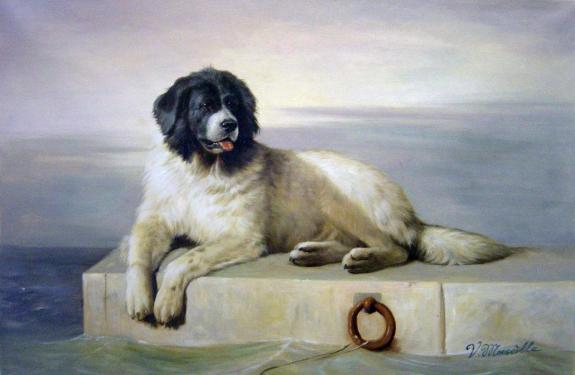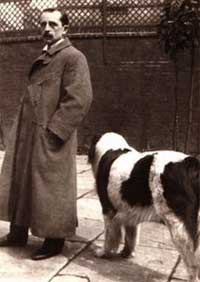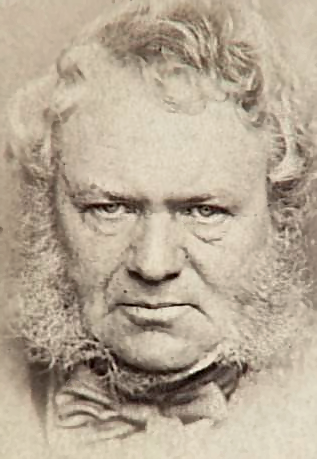
One of the most famous paintings of the 19th century is, “A Distinguished Member of Humane Society” painted by the renowned animal artist, Sir Edwin Landseer, in 1838. The dog in the image was said to have saved more than twenty people from a watery grave, and his heroism resulted in his being made a Distinguished Member of The Humane Society. Landseer had a penchant for painting these large white and black dogs that in the Victorian era were more popular than the solid black coloration. Because they were his favorite subjects to paint, the dogs came to be known as “Landseer dogs,” or simply Landseers.

J.M. Barrie, the author of Peter Pan, owned a Landseer named ‘Luath’
In the United States, Canada, and England, the “Landseer” is regarded as a color variety of the Newfoundland, but it is recognized as a distinct breed known as the ECT, or European Continental Type, by the Federation Cynologique Internationale (FCI) and several other kennel clubs in Belgium and Holland, as well as Germany which made a separate breed club for Landseers in 1976. As of 1998, every country except the U.S. and Canada recognizes the ECT Landseer as a separate breed from the Newfoundland.
That these were two different breeds was an opinion made earlier by one Dr. Paul Trâger, a eminent member of the “German Club of the Newfoundland for the Continent” who announced at the beginning of the century: “It is very clear that these sister breeds are not only separated by their color. The Landseer surprises me by their height and their mass. The shape or their heads is also very different. We can no more pretend that one breed comes from the other.” Others concurred after observing that Landseers were not only a taller, longer legged dog with a more tapered head, tighter lips, and more white on them, but that they were more active than the black variety, as well.

Edwin Landseer
By the time Trâger made that comment, the first purely Landseer litter was thought to have been whelped in Holland in 1893. A second Landseer litter was born in Switzerland in 1902, and it was this litter that many considered to be the revival of the Landseer on the European mainland. Tragically, most of these dogs were killed during World War I. After the war, some enthusiastic breeders in the Netherlands, Germany and Switzerland began breeding Landeers again, but between 1945 and 1960, the Landseer Continental Type was bred as a part of the Newfoundland.
The breed fared better than the man who gave it its name. After the death of his mother, Edwin Landseer had a mental breakdown in 1840 from which he never fully recovered. His morale and self esteem was further damaged by the failure of a royal family painting and a railway accident that left him with a scar on his forehead. He became increasingly dependent on drugs and alcohol, and though he was knighted in 1850, Landseer suffered from depression, and substance abuse which impacted his painting that had turned increasingly violent and disturbing. Edwin still created works of art, his biggest commission at this time being the Lions of Trafalgar Square. By 1872, however, Landseer was certified as insane and died on in 1873.
Edwin’s last drawing was of a dog.
